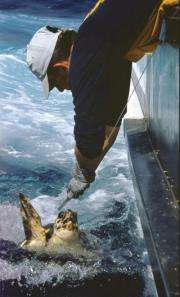How can accidental captures of loggerhead turtles be reduced?

Spanish scientists have studied interactions between the loggerhead turtle (Caretta caretta) and fishing gear such as longline hooks used at the water surface, mass beachings, and the effects of climate change on these animals. In order to reduce captures of this marine species without causing economic losses for fishermen, the scientists are proposing that fishing in the summer should only be carried out by night and in areas more than 35 nautical miles from land.
Populations of loggerhead turtles (Caretta caretta) are in decline all over the world, and particularly in the Mediterranean Sea, where more than 20,000 animals are accidentally caught each year. Finding responsible and sustainable fisheries solutions was one of the prime objectives of this research study, published in the latest issue of the Journal of Applied Ichthyology.
Researchers from the Spanish Institute of Oceanography (IEO) in Malaga, the University of Malaga (UMA) and the Sea Classroom, also in Malaga, tested whether using different kinds of animal bait would reduce captures of loggerhead turtles, and how these changes could impact on fishing yields.
The scientists used real commercial fisheries data taken by scientific observers on board fishing boats. The results were clear. "Using fish as bait could greatly reduce incidental catches of loggerhead turtles, but could also severely affect catches of swordfish", José Carlos Báez, lead author and a researcher at the IEO, tells SINC.
The research team also showed that stopping using small molluscs such as squid as bait could not ensure that incidental catches of loggerhead turtles would be prevented, since "as an opportunistic predator it also preys on hooks baited with fish, and can find these more easily when molluscs are used", explains the expert.
The study proposes other measures that, the researchers say, would not involve modifying the equipment used in any way that "could result in low economic yields because of a decline in fish catches", says Báez. These techniques would reduce the number of turtles caught while maintaining fishermen's profits.
"Most accidental catches happen during the day, more than 35 nautical miles from the coast, and in the summer, meaning that it would be enough to limit longline fishing at these times and places in order to drastically reduce captures of this species", says Báez, who adds that these measures should be tested before being adopted.
Longline fishing is practised by 356 vessels in Spanish waters, and provides employment for many coastal towns. However, accidental captures of species such as the loggerhead turtle are also damaging to fishermen's interests, because of the economic losses caused and the time spent in freeing the turtles.
More information: Báez, J.C.; Real, R.; Macias, D.; de la Serna, J.M.; Bellido, J.J.; Caminas, J.A. "Captures of swordfish Xiphias gladius Linnaeus 1758 and loggerhead sea turtles Caretta caretta (Linnaeus 1758) associated with different bait combinations in the Western Mediterranean surface longline fishery" Journal of Applied Ichthyology 26(1): 126-127, Feb 2010.
Provided by FECYT - Spanish Foundation for Science and Technology














